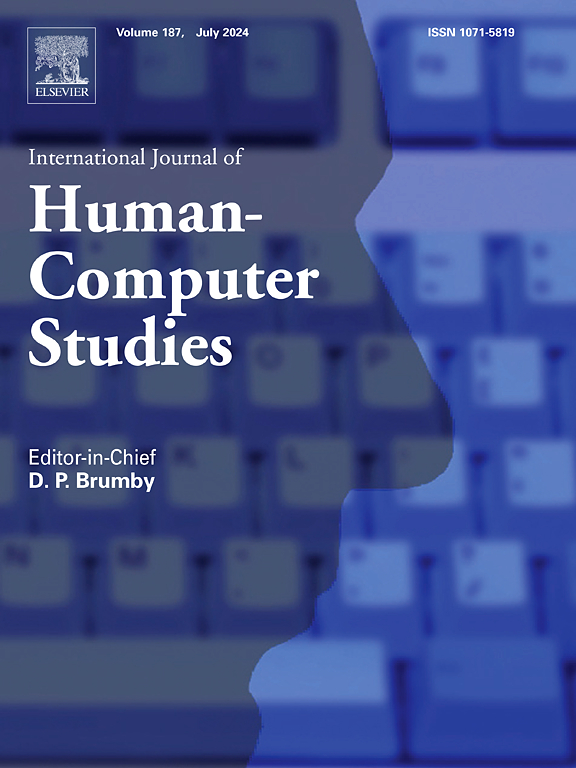AniBalloons: Animated chat balloons as affective augmentation for social messaging and chatbot interaction
IF 5.3
2区 计算机科学
Q1 COMPUTER SCIENCE, CYBERNETICS
International Journal of Human-Computer Studies
Pub Date : 2024-10-18
DOI:10.1016/j.ijhcs.2024.103365
引用次数: 0
Abstract
Despite being prominent and ubiquitous, message-based communication is limited in nonverbally conveying emotions. Besides emoticons or stickers, messaging users continue seeking richer options for affective communication. Recent research explored using chat-balloons’ shape and color to communicate emotional states. However, little work explored whether and how chat-balloon animations could be designed to convey emotions. We present the design of AniBalloons, 30 chat-balloon animations conveying Joy, Anger, Sadness, Surprise, Fear, and Calmness. Using AniBalloons as a research means, we conducted three studies to assess the animations’ affect recognizability and emotional properties (), and probe how animated chat-balloons would influence communication experience in typical scenarios including instant messaging () and chatbot service (). Our exploration contributes a set of chat-balloon animations to complement nonverbal affective communication for a range of text-message interfaces, and empirical insights into how animated chat-balloons might mediate particular conversation experiences (e.g., perceived interpersonal closeness, or chatbot personality).
AniBalloons:将动画聊天气球作为社交信息和聊天机器人互动的情感增强工具
尽管基于信息的通信非常突出且无处不在,但在非口头传达情感方面却很有限。除了表情符号或贴纸,信息用户还在继续寻求更丰富的情感交流方式。最近的研究探索了利用聊天气球的形状和颜色来传达情绪状态。然而,很少有研究探讨是否以及如何设计聊天气球动画来传达情感。我们展示了 AniBalloons 的设计,30 个聊天气球动画分别传达了快乐、愤怒、悲伤、惊喜、恐惧和平静。以 AniBalloons 为研究手段,我们进行了三项研究,以评估动画的情感可识别性和情感属性(N=40),并探究动画聊天气球如何影响即时通讯(N=72)和聊天机器人服务(N=70)等典型场景中的交流体验。我们的探索为一系列文本消息界面的非语言情感交流提供了一套聊天气球动画补充,并就聊天气球动画如何调解特定对话体验(如感知到的人际亲密度或聊天机器人个性)提供了经验见解。
本文章由计算机程序翻译,如有差异,请以英文原文为准。
求助全文
约1分钟内获得全文
求助全文
来源期刊

International Journal of Human-Computer Studies
工程技术-计算机:控制论
CiteScore
11.50
自引率
5.60%
发文量
108
审稿时长
3 months
期刊介绍:
The International Journal of Human-Computer Studies publishes original research over the whole spectrum of work relevant to the theory and practice of innovative interactive systems. The journal is inherently interdisciplinary, covering research in computing, artificial intelligence, psychology, linguistics, communication, design, engineering, and social organization, which is relevant to the design, analysis, evaluation and application of innovative interactive systems. Papers at the boundaries of these disciplines are especially welcome, as it is our view that interdisciplinary approaches are needed for producing theoretical insights in this complex area and for effective deployment of innovative technologies in concrete user communities.
Research areas relevant to the journal include, but are not limited to:
• Innovative interaction techniques
• Multimodal interaction
• Speech interaction
• Graphic interaction
• Natural language interaction
• Interaction in mobile and embedded systems
• Interface design and evaluation methodologies
• Design and evaluation of innovative interactive systems
• User interface prototyping and management systems
• Ubiquitous computing
• Wearable computers
• Pervasive computing
• Affective computing
• Empirical studies of user behaviour
• Empirical studies of programming and software engineering
• Computer supported cooperative work
• Computer mediated communication
• Virtual reality
• Mixed and augmented Reality
• Intelligent user interfaces
• Presence
...
 求助内容:
求助内容: 应助结果提醒方式:
应助结果提醒方式:


